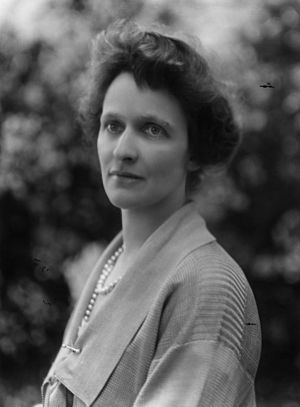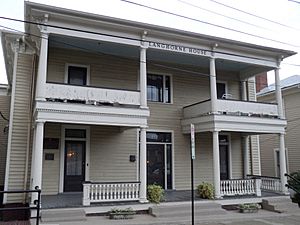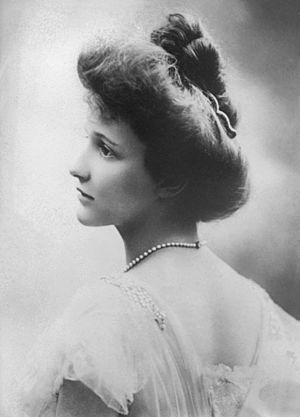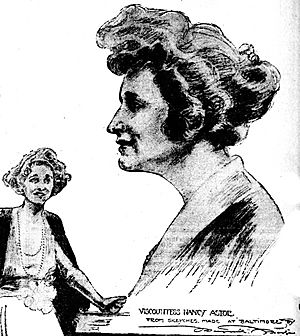Nancy Astor, Viscountess Astor facts for kids
Quick facts for kids
The Viscountess Astor
|
|
|---|---|

Nancy Astor (1923; age 44).
|
|
| Member of Parliament for Plymouth Sutton |
|
| In office 28 November 1919 – 15 June 1945 |
|
| Preceded by | Waldorf Astor |
| Succeeded by | Lucy Middleton |
| Personal details | |
| Born |
Nancy Witcher Langhorne
19 May 1879 Danville, Virginia, US |
| Died | 2 May 1964 (aged 84) Grimsthorpe, England |
| Political party | Conservative |
| Spouses |
Robert Gould Shaw II
(m. 1897; div. 1903)Waldorf Astor
(m. 1906; died 1952) |
| Children |
|
| Parents |
|
| Relatives | See Astor family |
| Residences | Cliveden and Grimsthorpe Castle |
| Occupation | Politician |
| Signature |  |
Nancy Witcher Langhorne Astor, Viscountess Astor, CH (born May 19, 1879 – died May 2, 1964) was an American-born British politician. She made history as the first woman to take her seat as a Member of Parliament (MP) in the United Kingdom. She served in this role from 1919 to 1945.
Nancy Astor's first marriage was to American Robert Gould Shaw II. They separated after four years and divorced in 1903. She then moved to England and married Waldorf Astor. When her husband became a peer and joined the House of Lords, she decided to enter politics. She joined the Conservative Party and won his former seat of Plymouth Sutton in 1919. This made her the first woman to sit as an MP in the House of Commons. She continued to serve in Parliament until 1945.
Contents
Nancy Astor: A Pioneer in British Politics
Early Life and Moving to England
Nancy Witcher Langhorne was born in Danville, Virginia, USA. She was one of eleven children born to railroad businessman Chiswell Dabney Langhorne and Nancy Witcher Keene. Her family faced financial struggles for some years after the American Civil War. However, her father later rebuilt his wealth.

By the time Nancy was thirteen, her family was well-off again. They moved to a large estate called Mirador in Albemarle County, Virginia. Nancy and her sisters were known for their beauty. Nancy attended a finishing school in New York City. There, she met her first husband, Robert Gould Shaw II. They married in 1897 when she was 18.
Their marriage was not happy, and they divorced in 1903. After her mother died, Nancy moved back to Mirador. She later visited England and loved it so much that her father suggested she move there permanently. In 1905, Nancy and her younger sister Phyllis moved to England.
Life in England and Second Marriage
In England, Nancy Shaw became known in society for her interesting personality and quick wit. Many wealthy young American women were marrying into the English aristocracy at that time. Nancy was known for being lively in conversation but also very religious and proper in her behavior.
She eventually married an Englishman, Waldorf Astor, who was also born in the United States. His family had moved to England when he was twelve. Nancy and Waldorf were a good match; they were the same age and born on the same day. After their marriage, the Astors moved into Cliveden, a grand estate in Buckinghamshire given to them by Waldorf's father. Nancy Astor became a well-known hostess for important social events.
The Astors also owned a large house in London. Lady Astor became involved with a political group called Milner's Kindergarten. This group believed in unity among English-speaking people and supported the British Empire.
Religious Beliefs
Nancy Astor became interested in Christian Science and eventually converted to this faith. She actively shared her beliefs with others. She also tried to encourage her friends to convert.
Astor held strong anti-Catholic views. She also tried to prevent the hiring of Jewish or Catholic people for senior roles at The Observer, a newspaper owned by her husband.
Entering Parliament
First Campaign for Parliament
Nancy Astor decided to run for Parliament after her husband, Waldorf Astor, became a peer. When his father died, Waldorf became the 2nd Viscount Astor. This meant he automatically became a member of the House of Lords and had to give up his seat in the House of Commons for Plymouth Sutton. Lady Astor then decided to run in the special election for that vacant seat in 1919.
Nancy Astor had not been deeply involved in the women's suffrage movement, which fought for women's right to vote. However, when she was elected, many suffragettes celebrated her victory.
During her campaign, Astor was criticized for her strong views against alcohol (teetotalism) and for not knowing much about current political issues. But she won over voters by talking about her charity work during the war and her quick wit. She was good at responding to people who tried to interrupt her speeches. Her informal style surprised and entertained the British public. She gained support from women voters by holding special meetings for them. On November 28, 1919, she won the election. She took her seat in the House of Commons on December 1, becoming a Unionist (or "Tory") Member of Parliament.
It is important to know that Nancy Astor was not the very first woman elected to the British Parliament. That was Constance Markievicz, elected in 1918. However, Constance Markievicz was an Irish Republican and chose not to take her seat in Parliament. So, Lady Astor was the first woman MP to actually sit in Parliament.
Early Years as an MP

Nancy Astor's time in Parliament was the most public part of her life. She stood out because she was a woman and sometimes didn't follow the usual rules, which people often linked to her American background. On her first day, she was told off for chatting, not realizing she was the one causing the noise. She learned to dress more formally and avoided the bars and smoking rooms where the men gathered.
She made friends with other women MPs, even those from different parties. She became friends with Ellen Wilkinson from the Labour Party. Astor later suggested creating a "Women's Party," but the Labour women MPs disagreed.
Nancy Astor's achievements in the House of Commons were not huge. She never held a very powerful position or became a minister. However, she was active outside of government. She supported the growth of nursery schools for children's education. She used her wealth to help with these social efforts.
During the 1920s, Astor gave several strong speeches in Parliament. Her fame brought attention to women serving in government. She worked to encourage women to join the civil service and the police force, and supported education reform. She was well-liked in her local area and in the United States during the 1920s.
In 1924, Astor became the first President of the new Electrical Association For Women. In 1925, she led the first International Conference of Women In Science, Industry and Commerce in London. She strongly supported women working in science, engineering, and technology.
Later Years in Politics
Challenges in the 1930s
The 1930s were a difficult time for Lady Astor personally and professionally. She won her election in 1929 by a small margin.
Her friendship with writer George Bernard Shaw helped her through some problems. However, his own tendency to make controversial statements sometimes hurt her political career.
During this period, her son, Bobby Shaw, visited the Soviet Union and spoke positively about it. This caused problems for Astor, who did not approve of communism. She even asked Joseph Stalin directly why he had harmed so many Russians. Her conservative supporters worried she was becoming too soft on communism.
Views and World War II
Astor was part of a group called the Cliveden Set. This group was sometimes seen as being too friendly with Germany before World War II. Astor herself was concerned about this image.
When World War II began, Astor admitted she had made mistakes. She voted against Prime Minister Chamberlain. However, some politicians still disliked her views. In 1939, a Labour MP called her "The Member for Berlin."
During the war, Astor's speeches became less clear. She also ran a hospital for Canadian soldiers, as she had during the First World War.
It is believed that Lady Astor was the first to call the soldiers fighting in the Italian campaign the "D-Day Dodgers" during a speech. She seemed to suggest they were avoiding the "real war" in France. The soldiers in Italy were very upset by this, and a sarcastic song called "The Ballad of the D-Day Dodgers" was written in response.
Final Years and Legacy

Lady Astor believed her political party and her husband forced her to retire in 1945. The Conservatives thought she had become a political problem. Her husband told her the family would not support her if she ran again. She agreed to step down but was reportedly very upset.
Lady Astor found retirement difficult, which strained her marriage. She and her husband began traveling and living separately. However, they reconciled before his death in 1952.
Lady Astor's public image suffered in her later years. Her views on different ethnic and religious groups became outdated. She expressed growing suspicion towards minorities. For example, she told African-American students that they should aim to be like the black servants she remembered from her youth.
After 1956, Nancy Astor became more isolated. In 1959, she received the Freedom of City of Plymouth. By this time, she had lost all her siblings and many close friends. Her relationship with her children also became distant. She died in 1964 at her daughter's home in Lincolnshire. Her ashes were buried at Cliveden.
Famous Sayings
Nancy Astor was known for her witty exchanges with Winston Churchill. While many stories exist, they are not always fully proven.
One famous story says that Churchill told Lady Astor that having a woman in Parliament was like someone walking in on him in the bathroom. She supposedly replied, "You're not handsome enough to have such fears."
Another story tells of Lady Astor saying to Churchill, "Oh, if you were my husband, I'd put poison in your tea." Churchill is said to have replied, "Madame, if I were your husband, I'd drink it with pleasure."
Remembering Nancy Astor
In 1982, the BBC aired a TV show about her life called Nancy Astor. In 2019, a bronze statue of Lady Astor was placed in Plymouth, near her former home. This was to celebrate 100 years since her election to Parliament.
Her views on certain groups have been criticized in recent years. However, many still recognize her important role as the first woman MP to take her seat in the British Parliament.
Children
- Robert Gould Shaw III (1898–1970)
- William Waldorf Astor II (1907–1966)
- Nancy Phyllis Louise Astor (1909–1975)
- Francis David Langhorne Astor (1912–2001)
- Michael Langhorne Astor (1916–1980)
- John Jacob Astor VII "Jakie" (1918–2000)
Images for kids
-
Portrait of Nancy Astor by John Singer Sargent, 1909
See also
 In Spanish: Nancy Astor para niños
In Spanish: Nancy Astor para niños






